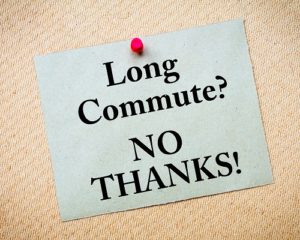
To Commute or Not to Commute? That is the Question

Commuting hasn’t yet made it to any Florida city’s list of desired attractions or activities, but perceptions of it are changing. Long commutes were once either avoided altogether or reluctantly accepted as a necessary evil. However with the rise in technology, heightened environmental concerns and more open-mindedness towards employee flexibility, workers from corporate executives all the way to bookkeepers are reconsidering how they handle their commutes to work.
5 Types of Commutes
-
Extreme/Super Commuting:
Flying or driving two hours or more in to another city on a Monday and returning home on Thursday or Friday.
This may sound extreme, which explains why it’s considered “extreme” commuting, but in certain circumstances it’s a lifesaver. Some, primarily executives, use this option when available to avoid uprooting their families. It provides the opportunity to accept an ideal job offer without having to deal with the disruptions to home life that often come with a new job.
And while it may seem strange that companies would even hire an executive who will not live in the local area, it’s becoming more and more common. Finding execs with the perfect skillset and experience is no easy task, so once they have been found, it’s important to seal the deal. Instead of paying thousands of dollars in relocation expenses that cover moving, temporary housing (to house families until they find permanent homes), home selling (unexpected costs homeowners face when selling their homes, especially when time-sensitive), etc., companies will sometimes opt to allow this type of commute.
-
Long-Drive:
An hour-long commute is a bit higher than the average but not extreme. It’s rather manageable and allows more than just the highest paid executives to accept dream jobs outside of their local areas. There are still additional expenses associated with the commute, and workers who choose it usually do so because the benefits outweigh them. Sometimes there are no comparable opportunities nearby, or jobs in their field are scarce.
-
Traditional-Drive:
Compared to other metropolitan areas, that’s not so bad. A number of workers, those with families in particular, typically choose this type of commute as it allows them to live in nearby suburban areas while still taking advantage of the economic opportunities within the city. The suburbs usually have lower housing costs, better public schools, and lower crime rates. This give many residents in the Tampa Bay area access to the best of both worlds in under 30 minutes. There’s no wonder why some consider this a no-brainer.
-
Ride-Sharing/Carpooling/Public transportation:
These are all ways to commute while minimizing related travel costs and driving responsibilities. 2017 statistics have shown a slight uptick in carpooling in recent years.
Carpooling is an arrangement between a group of people, who are usually travelling to the same or nearby destinations, to take turns driving the others. It essentially allows everyone to split the costs of travelling to work each week and helps to build a sense of community while reducing environmental pollution.
Online apps have gotten into the action in promoting ridesharing and carpooling. Waze Carpool, uberPool and Lyft Line are examples of some of the more popular ride sharing apps getting into the act of promoting carpooling. Here is a more comprehensive list of rideshare apps. It’s a great option for people who don’t own a vehicle as the cost is a fraction of what traditional taxis charge or work in an area with expensive parking fees.
Public transportation, while not the quickest mode of travel, is also a great way to save on commuting costs while protecting the environment. Many major cities usually have bus systems with regular routes, subways, and other transit systems the public can utilize for cost efficient travel.
5. Other:
Biking and walking to work are both viable options for people living relatively close to their jobs. They have positive effects on physical and mental health, financial savings, etc. And while St. Petersburg ranks as #1 in the state of Florida for its cycling atmosphere, other cities are making efforts to follow. Take the Bike Buddy Program in Tampa for example. It’s a free service through the Tampa Bay Area Regional Transportation Authority that matches bicycle commuters with one another. It helps to encourage cycling safety, reduce traffic congestion, increase physical activity, etc.
Are There Any Alternative Options for Those Who Still Have No Desire to Commute?
Sure there are – provided your employer is open and amenable to these concepts.
-
Virtual Work:
Although not as popular as one might think, working virtually is gaining acceptability in some realms. With improved technology, companies can hold meetings, communicate with staff, and respond to requests and other issues without stepping foot inside of an office.
-
Flexible Work Schedule, Part-Time Commuting:
Some companies will allow employees to come into the office two or three days a week and work from home for the remaining days. For certain positions, some face time in the office is a necessity. Splitting the work week between the office and home is a compromise that can be used to balance various demands for those who don’t need to make a daily appearance.

So, Is Commuting Ever Really a Good Thing?
That depends on who you ask. Some people embrace it and others, not so much.
The chief complaint among those who are against commuting is that it removes valuable time from their lives and the additional financial expense.
To counter this, some workers have found some productive ways to take advantage of the time:
- Meditate before work.
- Listen to podcasts, current news, etc. to help them be more effective in their work day.
- Get organized. Make to-do lists. Be productive in ways that save time and money.
- Work on a hobby, i.e., writing, drawing, etc.
- Conference/catch up calls with colleagues or clients.
- Use the time to catch up with family and friends on phone calls.
Your chances of finding enjoyment in your commute are much greater if you are able to utilize the travel time in ways that add value to your life. Take time to consider your needs, and assess the likelihood of you being able to fulfill any of them on a ride or drive in to work. And remember, the decision of whether or not to commute is a personal one. Different circumstances warrant different choices. The good news is that many cities and employers are becoming more supportive of those who choose longer commutes. Regardless of how long of a commute you are willing to endure, you will probably be in good company.
Ready to discuss the recruiting or job search process? Drop us a note!
"*" indicates required fields
